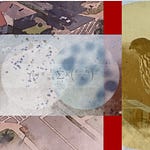Hello Interactors,
My daughter has developed a keen interest in synthesizers. She has even created illustrated characters named Morg and Snorf, inspired by keyboard brands like Korg and Nord. Recently, she borrowed an old Korg synthesizer and has begun composing her own music during what she calls, “Korg time”.
The evolution of electronic music has been remarkable since its inception, with even classical composers now embracing technology in their work. Notably, Ada Lovelace, one of the earliest computer programmers, foresaw in 1842 that computers would eventually be used for music composition — a prediction that has come to fruition.
The blending of acoustic music and computer-generated sounds prompts me to reflect on how we shape our environment, which in turn shapes us. This interplay mirrors the story of evolution: nature nurturing nature ad infinitum.
However, I wonder if technology as we know it today will ever truly integrate into the fabric of nature. Will we see human-like robots or robot-like humans? What if technology is already embedded within nature, and we are on the brink of learning to program it just as we would a computer?
Let’s find out…
MAN OR MACHINE?
“Are we not men?” This was a question presumably posed to and by members of the band DEVO who masquerade as part human and part machine. The answer by the humorous humanoids was “We are Devo!”. This question and answer became the title of their first album in August of 1978. It served as both a declaration of their band name, DEVO, but also as a rhetorical question that questioned humanity during the early rise of digital technology and its perceived, and actualized, dehumanization.
DEVO is an abbreviation of the term de-evolution. The band’s founding member, lead singer, and keyboardist, Mark Mothersbaugh had come across a 1924 pamphlet produced by Rev. B.H. Shadduck titled “Jocko-Homo Heavenbound” which critiqued, often humorously, Darwinian evolutionary theory.

“Jocko-Homo” translates to Ape-Man which refers to human’s evolution from apes. The critique is born out of teleology — the belief organisms are the design of a Christian god…and may be subject to evolutionary decay. Some claimed that by not adhering to the moral precepts of strict forms of Christianity, like dancing or drinking alcohol, that you could pass along devolving genes to your children. As a society, it could lead to a backwards slide of humanity, a devolution.
As art students at Kent State, Mothersbaugh and co-founding member and friend Gerry Casale were mostly drawn to the satire and comedic illustrations in ‘Jocko-Homo’. But the book’s premise came to the fore when they witnessed the killing of student war protesters in 1973. It made them wonder if perhaps humans really were devolving. After all, the Ohio National Guard had acted more like killing machines, not thinking or feeling humans. They seemingly failed to ask themselves, “Are we not men?”
Mothersbaugh and Casale had already begun experimenting with guitar laden punk rock when Mothersbaugh saw Brian Eno perform a synthesizer solo with the band Roxy Music. He’d heard plenty of synth solos from other bands of the 1960s and 70s, but no one played it like Eno — bending and twisting electronic knobs and dials like guitarists and singers bend strings and larynx muscles. Eno sounded and dressed like he’d been transported from the future or another planet.
Just a few years later, Brian Eno became the producer for DEVO’s first album, “Q: Are we not men? A: We are Devo!”. The album included the song “Jock-Homo” which featured short bursts of monkey sounds Eno synchronized with the machine-like beat of the song. Much like acts of the time, like Roxy Music and David Bowie, DEVO leveraged stage theatrics to convey their message. Their performances featured matching futuristic outfits, often with their red signature energy dome hats. Their choreographed robotic movements reinforced a cyborg-like identity serving as a visual critique of modern society's mechanization.
As AI and robots of today have captured the attention of a global society seemingly in decay, it may sound cliché to say, but they, and their contemporaries, were ahead of their time. While I don’t believe we are devolving, I do think DEVO accurately portrays, both theoretically and practically, a blending of man and machine that may just be part of developmental evolution — though perhaps not exactly as Darwin had envisioned.
Interestingly, DEVO could not have known their band name would become part of a branch of evolutionary biology, called Evo-Devo, or evolutionary developmental biology. That abbreviated term emerged in the early 1980s, perhaps inspired by DEVO.
GEOGRAPHY GUIDES GROWTH
Evo-Devo, which evolved from 19th-century embryology, explores how the development of an organism grows and matures from a single cell into a fully formed adult. It considers how cell division, their differentiated specialization for specific functions, the development of the resultant organism’s shape, and body structures and organs shape evolution.
Early thinkers like Karl Ernst von Baer and Ernst Haeckel recognized how species shared similar early developmental stages but then differentiated at later stages. The genetic underpinnings of this wouldn't be fully understood until much later. Darwin recognized these genetic developments as potential drivers of evolutionary change, but it took the Modern Synthesis of the 1930s — which focused on genetics and natural selection — to realize these ideas.
By the 1970s, the discovery of mutation genes like Hox genes (which control the body plan of animals) reignited interest in the connection between development and evolution. This research demonstrated how small tweaks in developmental processes could lead to dramatic changes in form. In the 1990s, Evo-Devo solidified as a field, with researchers like Sean B. Carroll emphasizing gene regulation’s critical role in shaping life’s diversity.
Today, Evo-Devo has expanded, embracing genomics and epigenetics to explain how organisms evolve through the complex interplay of genetic and environmental factors, reflecting a broader and more dynamic vision of evolution. In a sense, DEVO’s fusion of human and machine echoes these evolutionary dynamics, where both biological and technological systems evolve through reconfiguration and integration, creating emergent complexity that Darwin could not have imagined.
While Darwin spent years observing the interplay between biology and the physical environments of the Galápagos and beyond, he also could not have fully anticipated the extent to which physical forces directly influence biological development and shape natural selection.

Physical forces play a crucial role in shaping the development of complex biological structures. Mechanical stress, for instance, influences how cells behave during growth and regeneration. Cells respond to tension and pressure in their environment through mechanotransduction — where physical signals are converted into biochemical ones — allowing tissues to adapt to their surroundings.
This process is essential, for example, for the simple healing of a small cut to the complex formation of organs where precise force patterns ensure proper development. Similarly, physical stressors like fluid dynamics and gravity are critical in determining the structural features of organisms. In mollusks, for example, the formation of their shells is heavily influenced by the mechanical forces exerted by water currents and the mollusk’s own movements.
These physical inputs guide how calcium carbonate is deposited, shaping the unique curvature and strength of their shells. These examples highlight how environmental forces and biological development are deeply intertwined, driving evolutionary change through the interaction of physical and genetic processes.
This view aligns with the work of researchers like Michael Levin, who propose that environmental cues, including bioelectric and biochemical signals, play a crucial role in guiding the development and behavior of organisms. Michael Levin is a pioneering figure in the field of developmental biology and regenerative medicine, where his groundbreaking work explores how organisms use bioelectric signals to guide growth, regeneration, and even behavior.
His research has expanded our understanding of how cells communicate beyond traditional biochemical and genetic pathways, showing that electrical signals between cells play a critical role in shaping an organism’s development. Levin, and his collaborators, has demonstrated how manipulating these bioelectric signals with computer programs, they can reprogram biological processes — enabling, for example, the regeneration of complex structures like limbs in animals.
This represents a major shift in biology, as it challenges the conventional view that genetic blueprints alone dictate development, highlighting instead the role of bioelectricity as an under appreciated but vital component of life’s regulatory networks. In other words, genes can be thought of as hardware and they communicate, collaborate, and compete through bioelectronic circuitry, or software.
BLURRING BOUNDARIES, REDEFINING LIFE
Michael Levin's research, and others, emphasize that biological systems — whether single cells or complex organisms — operate through networks of bioelectrical, biochemical, and biomechanical signals, processing information much like computers. Cells communicate and make decisions through these signals, allowing them to respond to their environments. In this way, living organisms already function as computational entities, capable of performing sophisticated tasks typically associated with artificial systems.
Levin’s vision extends into synthetic biology, where organisms might be engineered to function like programmable devices. By manipulating bioelectric and cellular signals, scientists could design organisms capable of performing specific tasks, responding to commands, or adapting their behavior, effectively merging biology with computation. This concept could, for example, blur the distinction between biological pets and programmable machines, imagining a future where living systems are fully customizable.
This integration of biology and technology is further reflected in the development of soft robotics and biohybrid systems, where machines incorporate biological tissues for enhanced sensory and adaptive functions. Levin's work on bioelectricity supports the idea that these biological machines could operate through naturally occurring computational processes, challenging traditional distinctions between organic life and artificial intelligence.
Clearly these developments raise profound ethical questions, and Levin is the first to say it. It poses many questions about the nature of intelligence, the potential for sentient machines, and the rights of biologically-based computing systems. But these developments could also help advance some of our most pressing health problems.
Including in the brain. There’s already a brain grown in a petri dish that can learn to play Pong. Called organoids, these are lab-grown, miniature models of human organs, developed from stem cells, can replicate structural and functional characteristics of actual organs.
Brain organoids, in particular, mimic basic aspects of brain architecture and neural activity, allowing researchers to study development, disease, and neurological functions in controlled environments. These "brains in a dish" have advanced to the point where they can exhibit learning behaviors, like playing Pong.
In this experiment, a brain organoid was connected to electrodes, which allowed it to interact with a simplified version of game. Over time, the organoid learned to play the game by modulating its neural activity in response to feedback from the game environment. This groundbreaking demonstration revealed the potential of organoids not only for studying brain function but also for creating neural systems capable of learning and adapting, pushing the boundaries of artificial intelligence and bioengineering.
Such advancements highlight the possibilities of merging biological neural systems with computational tasks, a direction that may influence both neuroscience research and the future of AI. I wonder if DEVO ever imagined their man-machine themes and robotic humanoid movements would have emerged, in experimental form, in their lifetime.
DEVO and their contemporaries didn’t just create music; they engineered an evolutionary shift in sound that mirrored both cultural and biological processes. By blending analog instruments with emerging technologies like synthesizers and drum machines, their work reflected the modularity featured in Evo-Devo, where biological traits evolve through the recombination of existing genetic modules.
Just as Evo-Devo shows how small adjustments in developmental pathways lead to novel evolutionary outcomes, DEVO’s music was a synthesis of tradition and innovation, where new soundscapes emerged from reconfiguring the familiar all influenced by the culture and environment in which they exist. This creative evolution parallels biological processes, where complexity arises not linearly but through recursive adaptation and innovation often resulting in sudden unexpected leaps.
Much like geography’s dynamic role in shaping biological evolution, DEVO’s sound was also shaped by external forces — cultural, technological, and industrial. In biology, physical environments like mountains, rivers, and urban landscapes impose selective pressures that drive adaptation, and similarly, DEVO’s music arose at the intersection of human creativity and technological advancement.
These external forces didn’t serve merely as a backdrop but as active, reshaping elements, much like how geographic isolation on islands drives rapid speciation. The adaptability of organisms to urban environments mirrors how DEVO adapted the rigid precision of machines into organic, expressive art, blending the mechanical with the human, much like how species blend with their changing habitats.
This fusion of man and machine is now emerging in the cutting-edge field of synthetic biology, where organisms are engineered to function like programmable devices. In the same way that DEVO’s music blurred the lines between human creativity and machine precision, synthetic biology allows for living systems to be designed with programmable traits, merging the biological with the technological. Maybe Morg and Snorf will not just be 3D models on a 2D screen, but real bio-sythentic musical pets that invent and collaborate on music together — and with us.

These biohybrid systems, where living organisms can perform tasks traditionally associated with machines, further illustrate the evolution of complexity through reconfiguration. Whether in music or existence, the distinctions between what is natural and what is artificial are growing more ambiguous, illustrating the continuous evolution driven by adaptation, creativity, and the interaction with outside forces.
References:
Fortner, Stephen. "Devo: The Masters of Subversive Synth Rock Return." Keyboard, 1 Sept. 2010, https://www.moredarkthanshark.org/eno_int_keyboard-sep10.html.
Wanninger, Andreas, and Tim Wollesen. "The Evolution of Molluscs." Frontiers in Ecology and Evolution 6 (2018): 1-22. https://www.ncbi.nlm.nih.gov/pmc/articles/PMC6378612/.
Conversation with ChatGPT on intersections between Evolution, Geography, and Biological Computing. September, 2024. https://chatgpt.com/.













